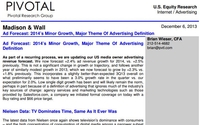Analyst Reaffirms 'Modest Growth' Outlook, Implies Big Shift Is In How Advertising Is Defined
- by Joe Mandese @mp_joemandese, December 6, 2013
 On the
eve of the Madison Avenue’s major ad outlook updates, influential Wall Street analyst and former ad industry insider Brian Wieser this morning issued an update of his ongoing advertising model,
reaffirming “modest growth” for 2014, but also questioning the underlying definition of what constitutes “advertising” in an era of accelerated technological change.
On the
eve of the Madison Avenue’s major ad outlook updates, influential Wall Street analyst and former ad industry insider Brian Wieser this morning issued an update of his ongoing advertising model,
reaffirming “modest growth” for 2014, but also questioning the underlying definition of what constitutes “advertising” in an era of accelerated technological change.
“As part of a recurring process, we are updating our U.S. media owner advertising revenue forecast. The updates in our model would mostly be described as ‘tweaks’ at a macro-level, because the numbers don't change by much from our recent revisions,” writes Wieser, a senior research analyst following the advertising and media industry at Pivotal Research Group, and former head of forecasting at Interpublic's Magna unit.
advertisement
advertisement
Based on his tweaking, Wieser took his U.S. ad outlook down a smidge, calling for aggregate growth of 2.4% in 2014, vs. the 2.5% expansion he had previously forecast.
“This is not a significant change in growth or trajectory, and follows another year of similarly modest growth in 2013, which we now forecast to grow by +2.3% vs. +1.8% previously. This incorporates a slightly better-than-expected 3Q 13 overall on what preliminarily seems to have been a 3.0% growth rate in the quarter vs. our expectation for 2.0%,” Wieser explains adding that a more significant shift is “underway within many different sub-sectors,” including the ongoing shift toward national from local ad budgets, and a serious baseline beginning to manifest for online video vs. conventional TV ad spending.
“Our total TV forecast over five years is down slightly vs. forecasts we made earlier this year, while digital is growing slightly faster,” he writes, citing one of his ongoing themes that Nielsen's aggressive push to make its Online Campaign Ratings a TV-like standard for trading online video the way agencies and advertisers use TV ratings. Wieser has been a major proponent of the impact of that shift, especially given Google's recent decision to begin tagging ad campaigns running on YouTube.
“Online video probably does start to take more budget share over time as Nielsen's OCR takes root to the benefit of stand-alone services with digital video ad inventory, ” Weiser reasserts, adding: “Overall, digital growth is primarily benefitting the haves such as Google, Facebook, and anything programmatic, while the have-nots such as especially portals and notionally premium content continue to contract. Print of all types continues to decline, while radio and outdoor can be viewed as stagnating, unless those media are defined to include internet radio and digital out-of-home, respectively.”
In a more telling analysis, Wieser implies that ad spending forecasts may be becoming somewhat semantic, as the underlying way the industry defines advertising also begins to shift.
“If we define advertising in an unchanging way, we ignore that advertisers themselves are changing what they are doing and that they increasingly influence broader pools of money than just the advertising budget line,” he suggests. “In our forecasting efforts, we have always drawn the line in defining advertising as we have because defining media owners and the revenues they generated from advertising was pretty clear. A case could always have been made to include advertising agencies in a definition of the market, and increasingly we think that software-related solutions relating to marketing technologies could be included too, because we see growth trends for agencies and marketing technologies which will continually grow while media-related advertising as we have traditionally defined it is increasingly commoditized to many marketers and especially the procurement professionals who increasingly drive their decisions.”
Wieser cites the rapid evolution of nontraditional digital marketing platforms such as social and search, but also singles out “Salesforce.com, Adobe and others,” which are creating so-called “marketing cloud” services that blur the line between advertising, direct-response and database marketing, which might fall more broadly under the classification of “CRM,” or customer relationship management, than conventional advertising.
Wieser's tweaks come a day after he initiated coverage of Salesforce.com's stock with a “buy” rating, and asserting that it is “the company best positioned to capitalize on the growing role of technology in the broadly defined field of marketing.”
Madison Avenue’s more conventional ad forecast updates will be issued by major agency holding companies on Monday, during the first day of UBS' annual media industry conference in New York.


